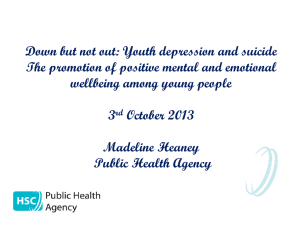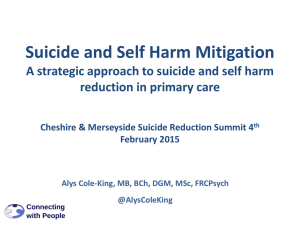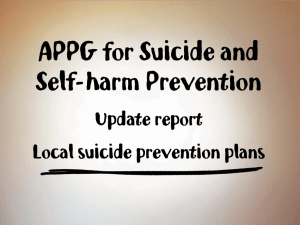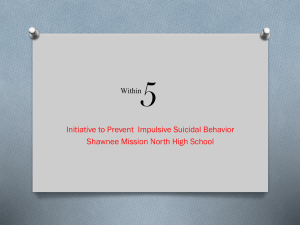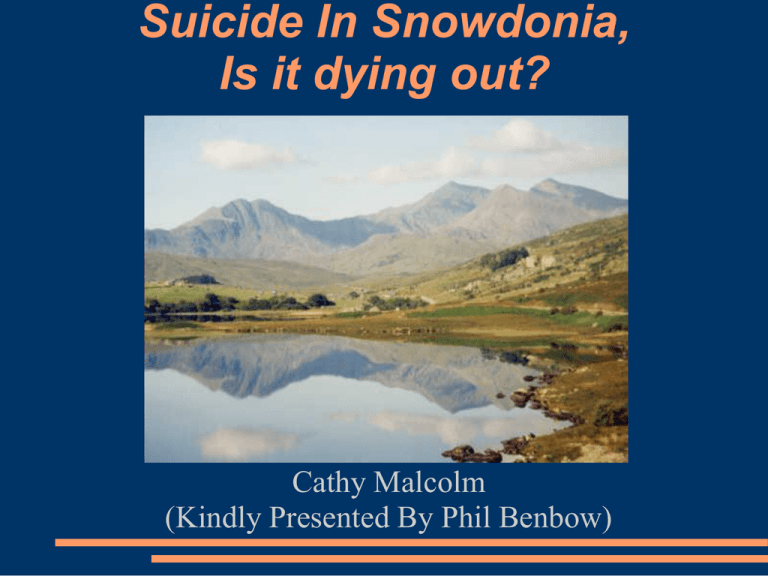
Suicide In Snowdonia,
Is it dying out?
Cathy Malcolm
(Kindly Presented By Phil Benbow)
Project Origin
Timely project, coincides with the National
Action Plan to Reduce Suicide and Self
Harm in Wales 2009-2014
300 suicide deaths annually in Wales
Especially prevalent amongst young people
Impetus for change high following Bridgend
suicides
Media ban on reporting details of Bridgend
cases, yet relationship between media
reporting and suicidal behaviour unclear.
Project Aims
1. To study the incidence of suicide and
attempted suicide in Snowdonia
2. To look at Snowdonia rates of suicide in
relation to other mountainous and rural areas
(national parks)
3. To see if Snowdonia is becoming a suicide
hotspot
4. To ascertain whether suicide rates increased
(copycat suicide) following the 2008 high profile
suicide of Michael Todd.
Method
Used the YG Mountain Medicine database to
identify all suicide cases, self-harm cases and
suspicious deaths
25 such cases recorded over the period March
2004- November 2010
Method of suicide or self-harm, age and gender
recorded
Location of suicide attempt recorded
Home address of all cases noted
Main Findings
Incidence of Suicides in Snowdonia. 3/2005-11/2010
10
9
8
No of cases
7
6
5
4
3
2
1
0
2005
2006
2007
2008
Year
2009
2010
Main Findings
METHOD – Overdose in 50% of cases
AGE – 40-45 most common age group
GENDER – 70:30 Male:Female ratio
LOCATION – 53% Found on Snowdon itself
PREMEDITATION – 63% of cases came from
England
PREVIOUS ATTEMPTS -52% of cases known
to mental health services prior to attempt
Inferences from results
Snowdonia is a suicide hotspot
Sustained increase in suicides since the Todd
case supports the existence of the copycat effect
Rural location attractive to vulnerable
individuals, especially men
No clear data on the incidence of suicide in
other national parks but this project provides a
baseline
Snowdon itself seems to hold iconic lure for
suicide attempts
A Word on the Copycat effect
The Copycat or Werther effect describes the
situation where an observer copies behaviour they
have seen modelled in the media
Celebrity status of suicide victim has shown to be
particularly influential
Current thinking suggests style of media reporting
is key
Media is thought to have a protective effect in
some cases
Many countries have now instigated media
guidance to encourage 'responsible' media
coverage of suicide
Recommendations
1.Trial of preventative measures to discourage
suicidal behaviour
2.MRT teams to provide treatment for suspected
overdoses
3.Mind Cymru offer free training in suicide
intervention skills for emergency services dealing
with suicidal patients
4.Similar research in other national parks is necessary
to quantify the scale of the problem in such areas
References
Suicide Prevention, Summary of the Evidence (2007) National
Public Health Service for Wales
Self Harm: the Short Term Physical and Psychological
Management in Secondry Prevention of Self Harm in Primary
and Secondary Care (2004) NICE, London
King and Frost (2005) The New Forest Suicide Prevention
Initiative Crisis vol 26: 1
Phillips DP, (1974) The influence of suggestion on suicide:
substantive and theoretical implications of the Werther effect
American Sociological review 39: 340-354





